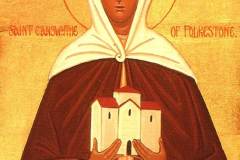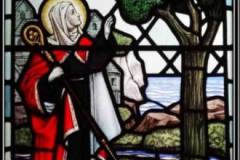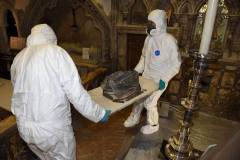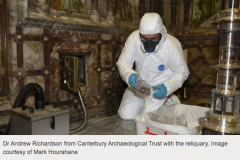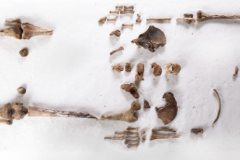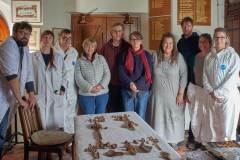Granddaughter of King Ethelbert and Queen Bertha Probable Founder of First Nunnery in England
In March 2020, the “Finding Eanswythe Project”, which included members from the Canterbury Archaeologoical Trust and Christchurch University, announced that human remains within a lead container at a church in Folkestone were almost certainly those of Saint Eanswythe. If so they are the only verified remains of the Kentish royal dynasty and are thought to be the earliest verified remains of an English Saint.
Eanswythe was the granddaughter of King Ethelbert and Queen Bertha. In AD 616 or 618 King Ethelbert died, and his son, Eadbald, caused a crisis in the spread of Christianity by marrying his own father’s widow (i.e. King Ethelbert’s second wife). Later, in 623 or 624 Eadbald married Ymme (Emma), who may have been the sister of the Frankish mayor of the palace of Neustria. (Neustria was part of the Frankish Kingdom; the land is now part of Northern France). Eadbald and Emma had 3 children, Eormenred, Earconberht and Eanswythe. Earconberht, who was Christian, became King of Kent after Eadbald’s death in 640.
There are scant details about Eanswythe’s life but it is believed that she founded a nunnery at Folkestone around the middle of the 7th Century. According to the account of a monk (writing in the 13th Century) Eanswythe wished to lead a religious and chaste life and chose Folkestone as being remote from society. Her father, or more likely her brother King Earconberht, built 2 churches on the site, a private oratory near the cliff’s edge, and a church of Saint Peter further inland, along with buildings for the nuns.
Eanswythe died as a young woman, and her relics have been moved several times, from the oratory, threatened with subsidence, to Saint Peter’s Church, and possibly to a Benedictine priory built on the site in 1095. In the 1130s a new church, dedicated to Saint Mary and Saint Eanswythe, was constructed nearby and the relics were translated into this church on 12th September 1138. The history of the shrine was unknown after the dissolution of the monasteries in the 1530s, but in June 1885 human bones were found concealed in the north wall of the church, and the Reverend Matthew Woodward believed them to be Eanswythe.
In the latest research, analysis of tooth and bone samples reveal an age of death of between 17-22 years. Radiocarbon dating suggests a date of death after 653, may be around 660. Thus the findings are compatible with the relics being those of Saint Eanswythe, and it is hoped that more research including stable isotope analysis and DNA analysis will provide further insights into her life and ancestry. The form of the lead container is typical of the 8-9th centuries but may have been made from re-used Roman coffins.
With acknowledgement & thanks to Dr Andrew Richardson, FSA, of Canterbury Archaeological Trust
Links:
For a contemporary account of the discovery and description of the reliquary in the 1880s, refer to

